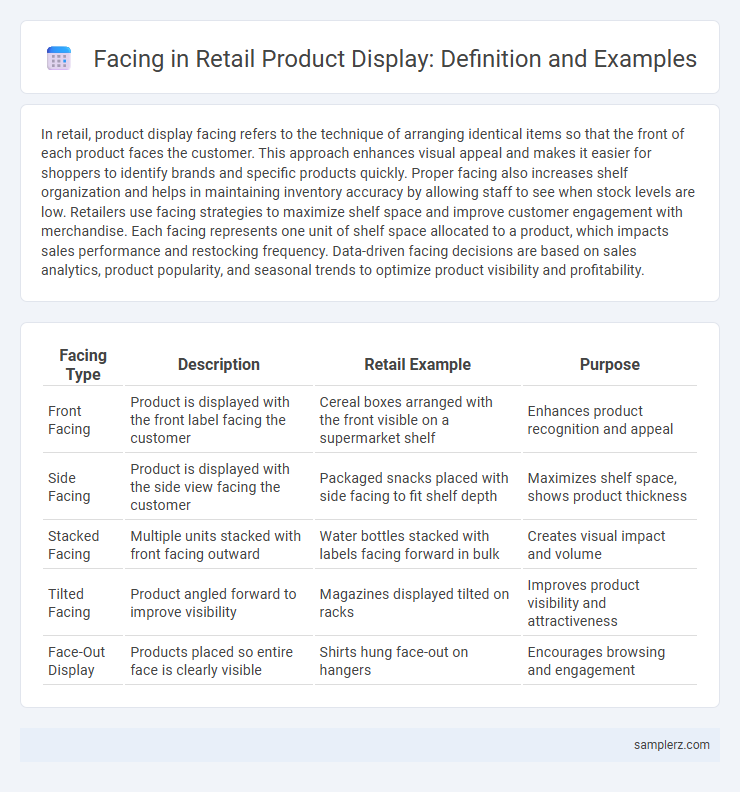In retail, product display facing refers to the technique of arranging identical items so that the front of each product faces the customer. This approach enhances visual appeal and makes it easier for shoppers to identify brands and specific products quickly. Proper facing also increases shelf organization and helps in maintaining inventory accuracy by allowing staff to see when stock levels are low. Retailers use facing strategies to maximize shelf space and improve customer engagement with merchandise. Each facing represents one unit of shelf space allocated to a product, which impacts sales performance and restocking frequency. Data-driven facing decisions are based on sales analytics, product popularity, and seasonal trends to optimize product visibility and profitability.
Table of Comparison
| Facing Type | Description | Retail Example | Purpose |
|---|---|---|---|
| Front Facing | Product is displayed with the front label facing the customer | Cereal boxes arranged with the front visible on a supermarket shelf | Enhances product recognition and appeal |
| Side Facing | Product is displayed with the side view facing the customer | Packaged snacks placed with side facing to fit shelf depth | Maximizes shelf space, shows product thickness |
| Stacked Facing | Multiple units stacked with front facing outward | Water bottles stacked with labels facing forward in bulk | Creates visual impact and volume |
| Tilted Facing | Product angled forward to improve visibility | Magazines displayed tilted on racks | Improves product visibility and attractiveness |
| Face-Out Display | Products placed so entire face is clearly visible | Shirts hung face-out on hangers | Encourages browsing and engagement |
Understanding Facing in Retail Product Displays
Facing in retail product displays refers to the number of product units placed at the front of a shelf to create a visible and appealing presentation. Proper facing optimizes shelf space, enhances product visibility, and influences consumer buying behavior by making items easier to locate and more attractive. Retailers often analyze sales data and customer flow patterns to determine the ideal facing count for maximizing both inventory turnover and shelf aesthetics.
Importance of Proper Facing for Retail Success
Proper facing in product displays significantly enhances shelf visibility and attracts customer attention, directly impacting sales performance. Consistent and well-aligned facing creates a visually appealing and organized presentation, encouraging shoppers to easily identify and access products. Retailers who prioritize facing techniques see improved inventory management and optimized space utilization, leading to increased revenue.
Common Types of Facing Methods in Retail
Common types of facing methods in retail include blocking, where identical products are aligned front-facing on shelves to create a clean, uniform appearance. Another popular method is signing, which uses clear, visually appealing labels or signage to direct customer attention to particular products. Shelf edging involves placing products at the front edge of shelves to maximize visibility and ease of access, enhancing customer engagement and boosting sales.
Horizontal vs. Vertical Facing: Key Differences
Horizontal facing arranges products side-by-side along the aisle, enhancing variety visibility and encouraging comparative shopping. Vertical facing stacks the same product one above the other in columns, boosting brand recognition and simplifying shelf restocking. Retailers use horizontal facing to highlight assortment breadth, while vertical facing optimizes brand impact and inventory management.
Example of Single Product Facing on Shelves
Single product facing on shelves highlights a specific item by placing one unit front and center to maximize visibility and consumer attention. This technique increases brand recognition and simplifies the shopping experience by drawing focus to the product's packaging and key features. Retailers use single facing to promote high-margin or new products, optimizing shelf space efficiency and driving sales performance.
Block/Brand Facing: Enhancing Product Visibility
Block or brand facing in retail merchandising involves arranging products front-facing on shelves to maximize visibility and brand recognition. This strategic display technique increases product accessibility, encourages impulse purchases, and reinforces brand identity by presenting a uniform and appealing storefront. Effective facing aligns products with consumer eye level, driving sales through increased engagement and streamlined shopping experiences.
Endcap Facing: Maximizing Promotional Impact
Endcap facing significantly boosts product visibility by positioning high-demand or promotional items at the aisle end, capturing shopper attention and increasing impulse purchases. Strategic arrangement and consistent facing maintain a clean, organized look that enhances brand appeal and drives sales conversion rates. Leveraging data-driven insights on consumer behavior allows retailers to optimize endcap displays for maximum promotional impact and inventory turnover.
Shelf Space Management and Facing Techniques
Effective shelf space management in retail involves strategically arranging products to maximize visibility and accessibility, directly influencing consumer purchase decisions. Utilizing facing techniques such as aligning products to the front edge of the shelf, increasing face-out products, and maintaining consistent product arrangement enhances brand presence and shelf appeal. Optimized facing increases product interaction by up to 30%, driving sales growth through improved shelf organization and targeted product placement.
Facing Mistakes: What Retailers Should Avoid
Facing mistakes such as inconsistent product alignment, overcrowding shelves, and neglecting front-facing items reduce visual appeal and confuse shoppers. Inadequate facing can lead to poor inventory management, lost sales, and diminished brand perception. Retailers must maintain uniform facings, ensure clear product visibility, and regularly adjust displays to optimize customer engagement and conversion rates.
Best Practices for Effective Product Facing in Retail
Effective product facing in retail involves aligning products uniformly at the front edge of the shelf to create a clean, organized appearance that attracts customer attention. Maintaining consistent facings based on product size and category enhances brand visibility and simplifies the shopping experience. Regularly auditing shelf facings ensures inventory accuracy and maximizes sales potential by showcasing high-demand items prominently.

example of facing in product display Infographic
 samplerz.com
samplerz.com